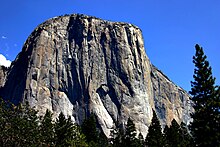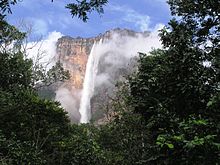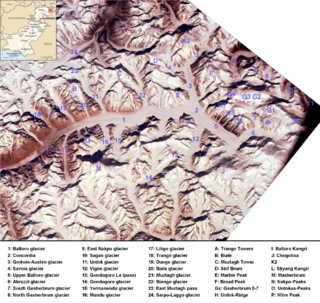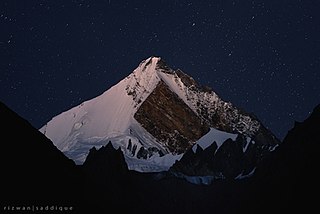This article needs additional citations for verification .(July 2021) |
The following is an incomplete list of cliffs of the world.
This article needs additional citations for verification .(July 2021) |
The following is an incomplete list of cliffs of the world.




Several big granite faces in the Arctic region vie for the title of 'highest vertical drop on Earth', but reliable measurements are not always available. The possible contenders include (measurements are approximate):
Other notable cliffs include:



K2, at 8,611 metres (28,251 ft) above sea level, is the second-highest mountain on Earth, after Mount Everest at 8,849 metres (29,032 ft). It lies in the Karakoram range, partially in the Gilgit-Baltistan region of Pakistan-administered Kashmir and partially in the China-administered Trans-Karakoram Tract in the Taxkorgan Tajik Autonomous County of Xinjiang.

In geography and geology, a cliff is an area of rock which has a general angle defined by the vertical, or nearly vertical. Cliffs are formed by the processes of weathering and erosion, with the effect of gravity. Cliffs are common on coasts, in mountainous areas, escarpments and along rivers. Cliffs are usually composed of rock that is resistant to weathering and erosion. The sedimentary rocks that are most likely to form cliffs include sandstone, limestone, chalk, and dolomite. Igneous rocks such as granite and basalt also often form cliffs.

The Karakoram is a mountain range in the Kashmir region spanning the borders of Pakistan, China, and India, with the northwestern extremity of the range extending to Afghanistan and Tajikistan. Most of the Karakoram mountain range falls under the jurisdiction of Gilgit-Baltistan, which is administered by Pakistan. Its highest peak, K2, is located in Gilgit-Baltistan. It begins in the Wakhan Corridor (Afghanistan) in the west, encompasses the majority of Gilgit-Baltistan, and extends into Ladakh and Aksai Chin.

Masherbrum is a mountain located in the Ghanche District, Gilgit Baltistan, Pakistan. At 7,821 metres (25,659 ft), it is the 22nd highest mountain in the world and the 9th highest in Pakistan. It was the first mapped peak in the Karakoram mountain range, hence the designation "K1".

Rakaposhi also known as Dumani is a mountain of the Karakoram range, located in the Nagar valley, Bagrote valley of the Gilgit-Baltistan territory of Pakistan. The mountain is extremely broad, measuring almost 20km from East to West. It is the only peak on Earth that drops directly, uninterrupted, for almost 6000m from the summit to the base.

Baltistan also known as Baltiyul or Little Tibet, is a mountainous region in the Pakistani-administered territory of Gilgit–Baltistan. It is located near the Karakoram and borders Gilgit to the west, China's Xinjiang to the north, Indian-administered Ladakh to the southeast, and the Indian-administered Kashmir Valley to the southwest. The average altitude of the region is over 3,350 metres (10,990 ft). Baltistan is largely administered under the Baltistan Division.

The Trango Towers are a family of rock towers situated in Gilgit-Baltistan, in the north of Pakistan. The Towers have some of the world's largest cliffs and most challenging big wall climbing; every year a number of expeditions from all corners of the globe visit Karakoram to climb the granite faces. They are located north of Baltoro Glacier, and are part of the Baltoro Muztagh, a sub-range of the Karakoram range. The highest point in the group is the summit of Great Trango Tower at 6,286 m (20,623 ft), the east face of which features the world's greatest nearly vertical drop.

The Baltoro Glacier, at 63 km (39 mi) in length, is one of the longest glaciers outside the polar regions. It is located in the Shigar District of Gilgit-Baltistan in Pakistan, home to some of the world’s highest mountains. The glacier runs through the Karakoram mountain range, close to K2, the highest mountain in the region at 8,611 meters. Three other nearby mountains within 20 kilometers are all above 8,000 meters as well.

Shispare is one of the high mountain peaks of the Batura Muztagh, the westernmost subrange of the Karakoram range in the Gilgit-Baltistan region of Pakistan.

The Baltoro Muztagh is a subrange of the Karakoram mountain range, in Baltistan region of the Gilgit-Baltistan, northernmost political entity of Pakistan; and in Xinjiang, China. The crest of the range forms part of the Pakistan-China border.

Askole, Askoli, or Askoly is a small town located in Shigar Valley, in the Gilgit–Baltistan region of Pakistan. Askole is located in a remote region of the Karakoram mountains 3,040 meters above sea level. It is notable for being the final settlement before one enters the wilderness of the high Karakorams.

Trango Glacier is a glacier in the Baltoro Muztagh range of the Karakoram in Baltistan, Gilgit-Baltistan, Pakistan.

Central Karakoram National Park is a national park located in Skardu district of Gilgit-Baltistan in Pakistan. It encompasses some of the world’s highest peaks and largest glaciers. Internationally renowned for mountaineering, rock climbing and trekking opportunities, it covers an area of about 10,000 sq. km and contains the greatest concentration of high mountains on earth. It has four peaks over 8,000 m including K2 (8611 m), Gasherbrum-I (8068 m), Gasherbrum-II (8035 m) and Broad Peak (8051 m), and sixty peaks higher than 7,000 m. The park was placed on the World Heritage Site Tentative List in 2016.

Nagar Valley is a former princely state and one of the ten districts of Gilgit-Baltistan, Pakistan. The valley is along the Karakoram Highway on the way north from the city of Gilgit. The valley is home to many high mountain peaks including Rakaposhi (7788m), Diran Peak (7265m), Golden Peak and Rush Peak.

Gilgit-Baltistan is an administrative territory of Pakistan in the northern part of the country. It was given self-governing status on August 29, 2009. Gilgit-Baltistan comprises 14 districts within three divisions. The four districts of Skardu Kharmang Shigar and Ghanche are in the Baltistan Division, four districts of Gilgit Ghizer Hunza and Nagar districts which were carved out of Gilgit District are in the Gilgit Division and the third division is Diamir, comprising Chilas and Astore. The main political centres are the towns of Gilgit and Skardu.

Tourism in Gilgit-Baltistan, an administered territory of Pakistan, focuses on its access to various mountain ranges and alpine terrain.

Drifika is a mountain peak in the Karakoram range, far west of the Transhimalaya.